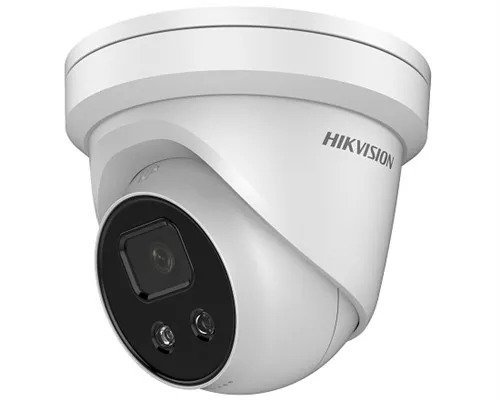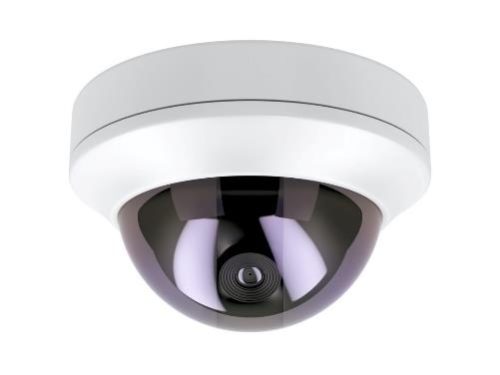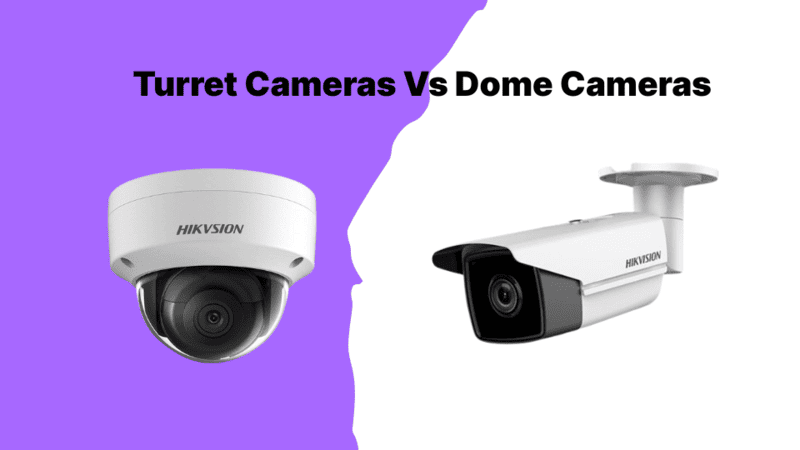Turret Cameras Vs Dome Cameras: The Ultimate Guide, Turret cameras, often called eyeball cameras, easy to spot because of their unique shape. They look like a “sliced sphere” or use a ball-and-socket design. This design lets the camera lens move easily. After you install it, you can aim it in any direction. Based on my experience, the 3-axis setup offers great flexibility. You can adjust the view angle without moving the whole camera, which I think is very convenient.
Introduction to Turret Cameras Vs Dome Cameras

What are Turret cameras
Turret cameras, often called eyeball cameras, easy to spot because of their unique shape. They look like a “sliced sphere” or use a ball-and-socket design. This design lets the camera lens move easily. After you install it, you can aim it in any direction. Based on my experience, the 3-axis setup offers great flexibility. You can adjust the view angle without moving the whole camera, which I think is very convenient.

What are Dome cameras
Dome cameras have a distinct dome-shaped cover. They offer subtle and flexible ways to watch over an area. People use them indoors and outdoors. Their smooth, rounded shape helps them blend in with buildings. I notice they fit well with different architectural styles. This subtle look makes them harder to see than other camera types, like bullet cameras.
Market Insights on Dome and Turret Cameras
• The global market for video surveillance was worth $45.5 billion in 2020. Experts expect it to reach $74.6 billion by 2025. (
Statista)
• Dome cameras make up about 35% of the security camera market. This shows how popular they are with users. I can see why, given their subtle design. (
Scoop Market Report)
• Turret cameras are becoming popular quickly. They’ve seen a 22% growth each year for the last five years. I recommend keeping an eye on this type.

Turret Cameras Vs Dome Cameras
Key Features and Looks
Turret Cameras
• Compact Size: They are small, usually 3-4 inches across. This makes them easier to install in tight spots.
• Full Rotation: You can easily adjust their position. The ball-and-socket style allows for flexible aiming.
• Open Lens: There’s no cover over the lens. This means you can clearly see the camera lens itself.
• Looks Like an Eyeball: People often call them “eyeball” cameras because of their shape.
Dome Cameras
• Dome Cover: The camera sits inside a dome-shaped case. You can get these covers in clear or tinted options.
• Bigger Size: Dome cameras are usually bigger than turret ones. Their width varies from 4 to 8 inches, making them more noticeable.
• Subtle Look: I think they blend well into ceilings. This helps make the surveillance less obvious.
• Damage Protection: Some dome cameras have tougher housings. This gives them extra security against vandalism.
How Turret and Dome Cameras Look Different
1.Lens View: On turret cameras, the lens is exposed. With dome cameras, the cover hides the lens direction.
2.Size: Dome cameras are often larger, measuring between 4-8 inches. Turret cameras are smaller, around 3-4 inches.
3.Adjusting: I find turret cameras simple to adjust. You can move the lens by hand without taking the housing apart, which is convenient.
4.Style: In my opinion, dome cameras have a smoother, more modern look. I would choose them for places where appearance is important.
Both camera types work well in different places. From my experience, turret cameras offer great flexibility and are easy to use. I suggest dome cameras when you need a discreet look and protection from tampering.
Installation Process
If you are choosing between turret and dome cameras, I think the installation process is an important thing to think about. Let me compare how easy each type is to install:
Installation Steps for Turret Cameras
Based on my experience, turret cameras are simple to install. You can also adjust them easily because they have a ball-and-socket design. Here are the steps I usually follow:
1.Mount the base where you want it.
2.Connect the power and network cables.
3.Adjust the camera angle to the position you need.
4.Lock the camera’s position.
Installation Steps for Dome Cameras
Dome cameras look less obvious, which is nice. But I find their installation takes more care and specific steps:
1.Take off the dome cover with care.
2.Mount the base firmly and connect all cables.
3.Adjust the camera inside to get the view you want.
4.Put the dome cover back on. Be careful not to bump the camera out of position.
Key Installation Differences: Turret Cameras Vs Dome Cameras
• Adjusting Later: It’s simpler to adjust turret cameras after they are installed. Dome cameras need exact setup from the start.
• Difficulty: In my opinion, installing turret cameras is simpler. They have fewer parts.
• Upkeep: You need to be more careful when handling a dome camera’s cover. This helps keep the view clear and the camera pointed correctly.
Field of View and Coverage Options
Turret Cameras: For Focused Views and Flexibility
• Turret cameras give you a wider field of view, often between 60 to 90 degrees.
• I find their ball-and-socket design really helpful. It lets you adjust the camera’s view easily. You don’t need to take the whole camera down and remount it.
• Based on my experience, these cameras work well for watching the edges of your property outside. They are also good for seeing things far away. I recommend them if you think you’ll need to change the camera angle often.
Dome Cameras: Wide Views with a Low Profile
• Dome cameras offer a very wide view, from 90 up to 360 degrees, depending on the specific camera.
• They are great for getting a full view of large indoor areas. I like using them indoors.
• Here are some key things I like about dome cameras:
◦ A single camera can capture a full 360-degree picture.
◦ Their shape is unobtrusive and blends well into the background.
◦ Many have strong, vandal-resistant cases. This gives them extra protection and makes them last longer, which I think is important.
My Placement Tips for the Best View
• For dome cameras: I suggest placing them on ceilings or high up on walls. This helps you get the most coverage in big rooms.
• For turret cameras: I recommend installing them on walls or poles. Place them around eye level or a bit higher to get precise views of specific spots.
• In bigger spaces, I always suggest using more than one camera. Combining cameras is a good strategy to cover any blind spots.
Turret Cameras Vs Dome Cameras: Comparing Image Quality
Superior Night Vision Performance
• Turret cameras give clearer night pictures because they don’t have a protective dome.
• Based on my experience, having no dome means less IR reflection and glare. This reduces image problems when it’s dark.
Improved Low-Light Capabilities
• Turret cameras use their IR LEDs better since no dome blocks the IR light.
• I find this gives you better sight in low light compared to dome cameras.
Reduced IR Bounce-Back
• Dome cameras often have problems with IR light bouncing back into the lens. This can create a washed-out look.
• Turret cameras fix this problem. I recommend them because they give sharper, more accurate night images.
Clearer Daytime Image Quality
• Reflections or bending of light from the dome on dome cameras can make images less clear.
• Turret cameras show sharper, more detailed daytime images. Their open design helps with this.
Enhanced Color Reproduction
• I’ve noticed many turret cameras now include good color night vision tech.
• This tech gives you brighter, more accurate colors, even when light levels are low.
Key Metrics in Image Quality
• Resolution: Both types offer similar choices (e.g., 2MP, 4MP, 8MP options).
• Frame rate: Also comparable, often providing 30fps at full resolution.
• Dynamic range: Turret cameras seem to have a small edge here (e.g., 120dB vs 110dB WDR).
• Minimum illumination: Turret cameras often work better in very low light. For example, they might need only 0.002 lux compared to 0.005 lux for dome cameras.
• IR range: Turret cameras often give you longer IR night vision distances. You might see ranges like 100ft compared to 80ft for dome cameras.
Durability and Protection Capabilities
Vandal Resistance
• Dome cameras have designs that resist vandals.
• I believe their strong dome covers guard against physical damage and hits. This makes them a good choice for high-risk areas where vandalism could occur.
• Most dome cameras I see have an IK10+ rating. This means they can take impacts up to 50 joules.
• Turret cameras do not have this protective shell. In my view, this makes them easier to damage in such places.
Weather Resistance
• Both turret and dome cameras resist weather well. They typically have IP66/67 ratings. This rating ensures they are protected from rain, dust, and snow.
• However, I think dome cameras often perform slightly better when the weather gets really bad, like during heavy snow or strong winds.
Durability in Extreme Conditions
• For harsh places, I suggest dome cameras. They give better protection and keep working even when conditions get tough.
• Their sealed design protects the inner parts well.
• Based on my experience, turret cameras, while okay for normal weather, might not hold up in extreme conditions as well as dome cameras do.
Maintenance
• I’ve noticed turret cameras often need cleaning more often. Their exposed parts seem to collect dirt or debris.
• Dome cameras have a closed design. I find they usually require less upkeep.
Turret Cameras Vs Dome Cameras: Comparing Their Uses
Turret Cameras for Outdoors
I recommend turret cameras for outdoor areas. They adapt well to different conditions. Their night vision is also better. Common places I use them include:
• Perimeter security around buildings and properties
• Parking lot surveillance for better monitoring
• Building entrances and exits to track who comes and goes
• Outdoor retail spaces like garden centers
Dome Cameras for Indoors
I prefer dome cameras for inside locations. You might need a camera that doesn’t stand out. These cameras work well in:
• Retail stores and shopping malls to watch customer activity
• Office buildings and lobbies for security that looks subtle
• Educational institutions like schools and universities
• Hotels and restaurants to keep the style while adding security
Key Differences I See in How They’re Used:
• Based on what I’ve seen, turret cameras provide 20-30% clearer night vision footage than dome cameras.
• Dome cameras usually give a 15-20% wider view.
• In my experience, changing the position of turret cameras after installing them is 30-40% easier.
• Dome cameras resist damage from vandals 25-35% better. This is because their parts are covered inside the dome.
Cost and Maintenance Comparison: Turret Cameras Vs Dome Cameras
Cost Breakdown:
• Turret Cameras: $100 – $300 per camera
• Dome Cameras: $80 – $400 per camera
In my experience, the price you pay changes based on different features. Things like picture clarity (resolution), seeing in the dark (night vision), and protection from weather affect the cost. I suggest looking closely at these features to see why prices vary.
Installation Costs:
• Professional Installation: $100 – $200 per camera
• DIY Installation: $0 – $50 for basic tools and supplies
Maintenance Expenses:
• Dome Cameras: I find you may need to clean the dome cover often to keep the view clear.
• Turret Cameras: Because some parts are exposed, I think you might need to adjust them now and then.
Long-Term Costs:
• Dome Cameras: I believe the protective shell helps them last longer.
• Turret Cameras: From what I’ve seen, you might need to replace these sooner. This happens more often if they face tough outdoor weather.
Turret cameras excel outdoors with superior night vision (60–90° FoV) and flexible ball-and-socket adjustments, ideal for parking lots and perimeters. Dome cameras dominate indoors, offering vandal-resistant domes (IK10), 90–360° coverage, and discreet aesthetics—perfect for retail or lobbies. While turrets adapt easily post-installation, domes demand precise setup but endure harsh conditions. Costs vary: turrets (100–300) prioritize clarity; domes (80–400) blend durability with subtlety.


